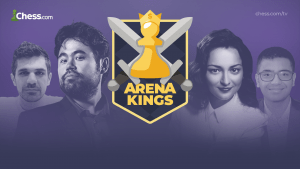
Master Path Study Plan: Strategy
Target Skill Range: Master Path (Rated 2000-2199)
Tasks:
- Learn the following master-level pawn structures.
- Master the art of maneuvering.
- Learn to use your pawns actively.
- Study the exploitation of pawn weaknesses.
- Identify critical moments in the game.
- Study the following players.
- Complete the following mentor lessons.
This study plan is but the beginning on an endless and wonderful journey. There is always more to learn about all aspects of chess, but it is the great ocean of strategy that you will find most deep as you improve. Never think that you fully understand chess strategy. Even the world's greatest players have much to learn, and strategic ideas are constantly being reevaluated.
In this study plan, pay special attention to those aspects that make positions unique. Although what you learn in one position may apply to other positions, it is important to be flexible and develop an ability to think creatively and uniquely. For example, in the first section, "Learn the following master-level pawn structures," you will see many structures that lead to certain ideas. In a game, you may be able to reuse one of those ideas. However, it is also possible that that idea does not work in the given position due to concrete factors in the position, and you need to select a slightly different plan.
Don't fight that! Open your mind and enjoy the wonder of strategy.
1. Learn the following master-level pawn structures.
"Ugh ... pawn structures again? I already know these!"
It's easy to think pawn structures are rudimentary. Isolated pawn, doubled pawns, etc. Right?
Not so! Masters know tons of pawn structures that are unique to certain openings, endgames, etc. Most don't even have names. Even for the best players in the world, it's impossible to know all of the pawn structures. Here are some more advanced pawn structures well worth studying.
Some of the most important pawn structures for any player are those that arise from their openings. Read IM Jeremy Silman's article which illustrates the importance of the idea.
Sometimes the moves that seem most anti-positional are the most instructive. Paradox always provides an opportunity for reevaluation. Watch this idea in action in GM Gregory Kaidanov's newest video.
In the following video and article, GM Bryan Smith and Kaidanov dive deep into the specifics of two totally different pawn structures, the e4-e5 pawn structure, and the Closed English structure. Watch the video and read the article to see a GM's subtle perspective on very specific pawn structures.
- The weak, "strong" e4-pawn
- The “Wide Battle” in Attack and Defense
- The King's Indian Exchange Structure
Also read this excellent 6-part series by WIM Iryna Zenyuk on "common" pawn structures and how to handle them.
- Typical Positions
- Typical Positions: Part 2
- Typical Positions: Part 3
- Typical Positions: Part 4
- Typical Positions: Part 5
- Typical Positions: Part 6
Finally double down on this topic with this two-part article on further pawn structures by IM Jeremy Silman.
2. Master the art of maneuvering.
Have you ever noticed that higher-rated players consistently have superior pieces? It's not advanced tactics or calculation or magic that leads to this imbalance. It's maneuvering.
Stronger players (of all levels) have a better sense of where their pieces need to be to be effective and how they need to get there.
At the master level, you will win fewer games by simply out-calculating your opponent. You need to outplay them. Improve these skills with the following lessons.
- Are You A Giant Of Positional Chess? by GM Gregory Serper
- The Best Knight Maneuver Ever by GM Simon Williams
- Bobby Fischer's Amazing Knight Move by GM Simon Williams
- Sicilian Attacks: Rook Lift by GM Dejan Bojkov
- The Nimzowitsch Knight Dance by GM Simon Williams
- The Positional Rook Lift by GM Daniel Naroditsky
Also read the following articles explaining the concept of maneuvering and some tremendous maneuvers in depth.
- The Art Of Maneuvering by GM Daniel Naroditsky
- The Power Of Positional Chess - Part 1: Maneuvering by IM Jeremy Silman
- The Rubinstein Maneuver by GM Daniel Naroditsky
3. Learn to use your pawns actively.
Pawns are often underestimated in attack. Learn to use your pawns to seize space, to create pawn breaks, and to support your pieces.
- Attack and Defense in the IQP by GM Bryan Smith
- The Truth About Doubled Pawns by GM Gregory Serper
- The Truth About Doubled Pawns, Part 2 by GM Gregory Serper
- Video Series on Playing with a Space Advantage in Chess by GM Alex Lenderman
- Structural Thinking by GM Melik Khachiyan
Supplement the videos you've watched by reading these articles on creative uses of pawns.
- Another g2-g4 lunge by Shirov by GM Bryan Smith.
- How To Ruin Your Pawn Structure by GM Daniel Naroditsky
Once you've watched these videos, put your knowledge to the test by completing the following lesson from IM John Grefe.
4. Study the exploitation of pawn weaknesses.
Can you win a game solely based on superior pawn structure? It is not uncommon for pawn weaknesses to be the decisive factor in a game, but once they are created, how do you make them count?
Learn about the exploitation of weaknesses (and when a weakness is not a weakness) by reading these excellent articles!
- How to Ruin Your Pawn Structure by GM Daniel Naroditsky
- Are Pawns The Soul Of Chess? by GM Gregory Serper
- Overextending Your Pawns by IM Jeremy Silman
- Doubled Pawns: Pariahs Or Misunderstood? by IM Jeremy Silman
5. Identify critical moments in the game.
Q: What is a critical moment in a chess game?
A: It's that seemingly unimportant part right before I make a mistake, right?
Well, maybe. Critical moments are those decisions that are likely to impact the result of the game. Most of the time, there are many good moves available to a chess player. Sometimes there are a few good moves and many wrong ones. Sometimes there is only one good move.
Critical moments include exchanges, radical changes in pawn structure, and also positions where one player can decide to alter the flow ( or, in other words, the character) of the game.
Those times when there aren't many good moves and you need to dig deeply to find a strong line of play are the critical moments. Complete these lessons to be more sensitive to critical moments in your own games.
How a Grandmaster Thinks: Making Decisions! by GM Gregory Kaidanov
IM David Pruess addresses this topic in following analysis videos.
How to Analyze Your Own Games: For Beginners!
How to Analyze Your Own Games: Beginner to Intermediate Level Players
How to Analyze Your Own Games 3: vs IM Sevillano!
Finally, watch IM John Bartholomew's incredibly series on how to sense that critical moment.
Sensing the Critical Moment - Part 1
Sensing the Critical Moment - Part 2
Sensing the Critical Moment - Part 3
6. Study the following players.
All chess players stand upon the shoulders of chess giants like the great GM Sammy Reshevsky, who was a towering five feet tall. Regardless of their physical height, the imposing intellects of great historical chess players informs the way we understand chess.
All great chess players are well-rounded players, but some have excelled particularly at certain aspects, contributing new ways of thinking, new values, and new priorities. Study the following players and pay particular attention to the discussed aspects of their play.
GM Sammy Reshevsky: A former child prodigy—Reshevsky was known for his technique, but he could surprise his opponent with attacking play, too.
GM Mikhail Botvinnik: Botvinnik possessed an iron logic and a scientific method of preparation; however, unlike many positional players, Botvinnik was very principled and often went for risky systems.
GM Paul Keres: A precursor of contemporary dynamic style, Keres based attack on a solid positional basis, winning his best games with ease and elegance.
GM David Bronstein: An imaginative player—Bronstein came close to winning the world championship, and is also known as one of the best authors in chess.
GM Vassily Smyslov: Smyslov's love of classical music shows in harmony on the chess board, especially in endgames.
GM Leonid Stein: With a great feel for initiative, Stein was a danger to any contemporary player, which he proved winning three U.S.S.R. Championships.
GM Efim Geller: A deep thinker—Geller was known for his complex opening concepts and love of analysis.
GM Mikhail Tal: Many of Tal’s legendary intuitive sacrifices were later refuted by analysts and computers, but that only increases his perception as one of the most revered players.
GM Tigran Petrosian: With a gift for predicting his opponent’s tactical ideas and positional plans, Petrosian elevated prophylaxis to new heights.
GM Boris Spassky: A universal player—Spassky was especially strong in middlegame, finding a way in many unclear positions.
GM Robert Fisher: A relentless drive to find the truth in every position defined Fisher’s style—a combination of maximalism and balance that continues to inspire chess fans.
GM Svetoszar Gligoric: His fundamental positional style helped to develop typical ideas for many opening systems that are still relevant today.
GM Bent Larsen: Who says romance is dead? If you are looking for offbeat, original ideas by a world class grandmaster, check out Larsen’s games.
GM Anatoly Karpov: One of the best intuitive players of all times, Karpov’s understanding of piece coordination in quiet positions and endgames was nearly flawless.
GM Viktor Korchnoi: Famous for his counterattacking style, Korchnoi enjoyed finding hidden resources in his games to show an outstanding example of longevity.
GM Garry Kasparov: Many consider Kasparov a maven of contemporary opening analysis, but it is his ability to infuse pieces with attacking energy that makes him one of the most instructive players of all times.
GM Viswanathan Anand: In his best games, Anand’s concrete approach and calculation prowess makes the champion from India as difficult to play as the best modern computers .
GM Vladimir Kramnik: One of the best positional players of all times, Kramnik is also known for his popularizing of the “Berlin Wall,” which remains the top choice for Black more than 15 years later!
GM Magnus Carlsen: Outplaying super-GM’s by “simply” maneuvering his pieces to the best squares, the current world champion’s games remind his numerous fans about the magic of chess.
7. Complete the following mentor lessons.
Lessons offer you the ability to test your strategic skills against the very best. See if you can identify (or even improve!) on the play of the incredible players presented in the following lessons.
Same Side Pawn Storms by GM Sam Shankland: Especially complete 3, 11, 12, 15, 18, 19, 20.
Sensing the Danger - Examples from My Games by GM Alex Lenderman.
Roots Of Positional Understanding by IM Jeremy Silman






